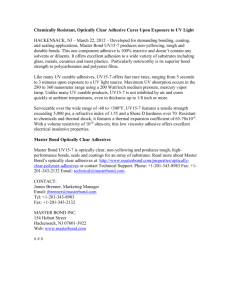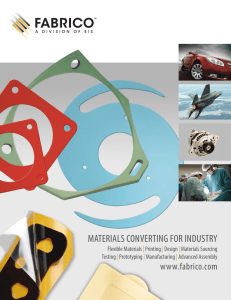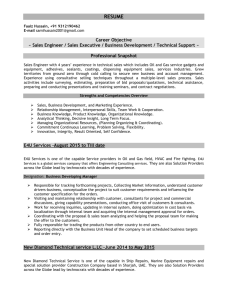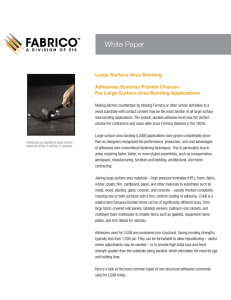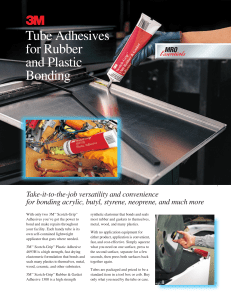Adhesives Enhance Large Surface Area Bonding Applications large surface area
advertisement
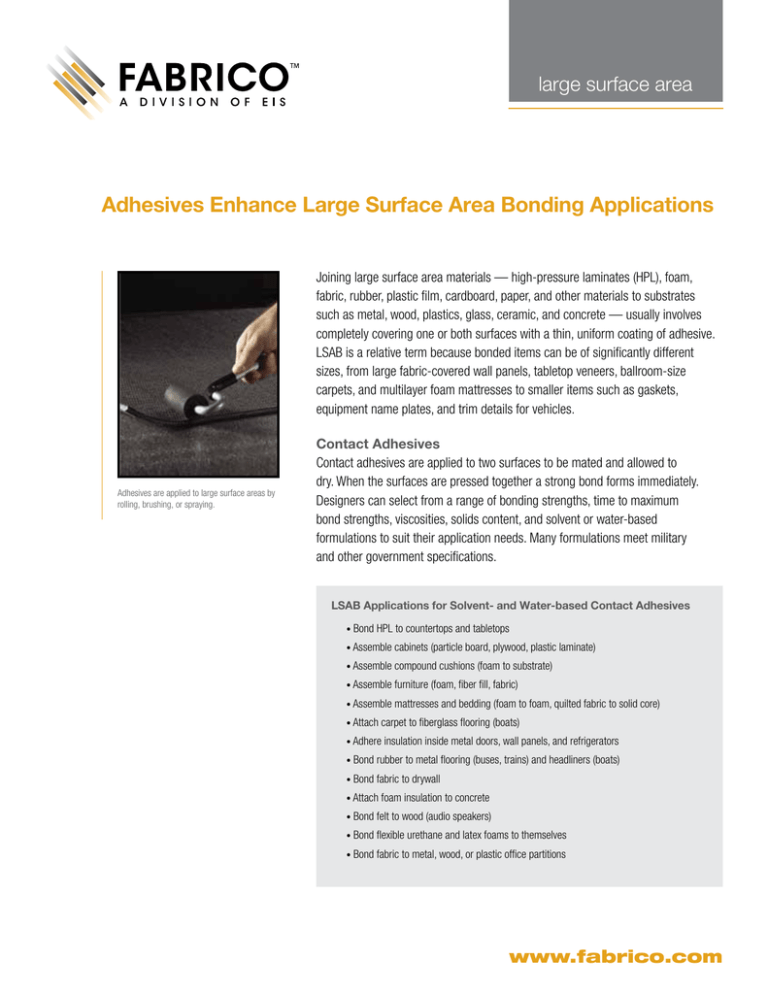
large surface area Adhesives Enhance Large Surface Area Bonding Applications Joining large surface area materials — high-pressure laminates (HPL), foam, fabric, rubber, plastic film, cardboard, paper, and other materials to substrates such as metal, wood, plastics, glass, ceramic, and concrete — usually involves completely covering one or both surfaces with a thin, uniform coating of adhesive. LSAB is a relative term because bonded items can be of significantly different sizes, from large fabric-covered wall panels, tabletop veneers, ballroom-size carpets, and multilayer foam mattresses to smaller items such as gaskets, equipment name plates, and trim details for vehicles. Adhesives are applied to large surface areas by rolling, brushing, or spraying. Contact Adhesives Contact adhesives are applied to two surfaces to be mated and allowed to dry. When the surfaces are pressed together a strong bond forms immediately. Designers can select from a range of bonding strengths, time to maximum bond strengths, viscosities, solids content, and solvent or water-based formulations to suit their application needs. Many formulations meet military and other government specifications. LSAB Applications for Solvent- and Water-based Contact Adhesives • Bond HPL to countertops and tabletops • Assemble cabinets (particle board, plywood, plastic laminate) • Assemble compound cushions (foam to substrate) • Assemble furniture (foam, fiber fill, fabric) • Assemble mattresses and bedding (foam to foam, quilted fabric to solid core) • Attach carpet to fiberglass flooring (boats) • Adhere insulation inside metal doors, wall panels, and refrigerators • Bond rubber to metal flooring (buses, trains) and headliners (boats) • Bond fabric to drywall • Attach foam insulation to concrete • Bond felt to wood (audio speakers) • Bond flexible urethane and latex foams to themselves • Bond fabric to metal, wood, or plastic office partitions www.fabrico.com Solvent- and water-based contact adhesives are frequently used to assemble mattresses and bedding. Aerosols are generally based on latex and neoprene solutions. Solvent-based nitrile rubber products with solids content of approximately 18% to 25% can generally be brushed, rolled, or sprayed. They produce strong, immediate bonds that achieve maximum overlap shear strengths of 480 psi to 540 psi in a short time (30 minutes maximum). Bonds resist heat, creep, and continuous load stresses. While solvent-based systems have the advantage of quick dry times, they have the disadvantages of growing health, safety, and environmental concerns. This has increased the popularity of water-based contact adhesive formulations. Because waterbased adhesives are non-flammable in the wet state, fireproof cabinets are not needed for storage. And there is no solvent odor. Various application methods can be used: spray, brush, or roller. Fans and heat accelerate drying. Aerosol Adhesives Aerosols, generally based on latex and neoprene adhesives, are similar to contact adhesives but most are formulated for applications requiring less strength and the ability to be repositioned. They are used for bonding light-weight materials including fabrics, plastics, flexible foams, paper, cardboard, and thin-gauge metals. Water-based aerosols are not yet available. Aerosol adhesives are formulated with a range of tack and bonding properties. Some specifically adhere difficult-to-bond, low surface energy (LSE) plastics like polyethylene film while others are designed for bonding expanded or extruded polystyrene insulation materials to themselves or other surfaces without degrading the foam. A plasticizer-resistant aerosol bonds vinyl, leather, and all types of rubber except EPDM. Another one-surface, pressure-sensitive spray formulation has tape-like instant adhesion to hold foam in place for shipping containers or for permanently bonding insulation in HVAC systems, appliances, and walk-in coolers. LSAB Applications for Aerosol Adhesives • Adhere • difficult-to-bond LSE plastics (polypropylene film, foam) Bond foam and fabric • Temporarily hold badges during stitching, T-shirts during screening, etc. • P ermanently attach carpet, nameplates, pool liners, pipe insulation • Attach paper-back fiberglass insulation, thin decorative films, foils, etc. • B ond expanded or extruded polystyrene and other insulation materials • B ond rubber, vinyl, leather, metal panels, kick plates, etc. (contact adhesive) • Form high-strength bonds for decorative laminates, and signage • S eal cardboard cartons, hold palletized plastic bags in place for shipping, apply labels Sprayable Hot Melt Adhesives Hot melt adhesives are one-part, 100% thermoplastic resins that flow when heated so they can be sprayed for LSAB applications. Applied to one or both surfaces, the sprayed material cools, hardens, and reaches ultimate bond strength in seconds. Hot melts are not for heavy-duty applications and are generally used for lightweight substrate bonding where high-temperature environments are not a factor. However, hot melts are an alternative to some solvent-based adhesives for quickly bonding many materials. They eliminate the need for solvent handling, and assemblies can be moved immediately after cooling. Aerosol adhesives are used for bonding light-weight materials including fabrics, plastics, flexible foams, paper, cardboard, and thin-gauge metals. Hot melts are an alternative to some solvent-based adhesives for quick bonding. Hot melt adhesives are available in low-melt and hot-melt formulations. Choose melt temperature based on materials to be glued (higher temperatures may be undesirable for some materials) and bond strength desired (higher melt temperature adhesives have better heat resistance). Low melts (250-270°F) • Formulations: hot tack, delayed tack, or removable gummy glue in a variety of clear and colored formulations • Usually hand-applied (not sprayed) • For smaller parts and perimeter sealing where 100% coverage is not required • Shear strengths for low melts: 350-600 psi (on Douglas fir at 72°F); peel strengths: 6-13 PWI (on canvas at 72°F); failure temperatures: 120-140°F Hot melts (350-385°F) • Formulations have higher heat resistance, the ability to bond LSE plastics, good environmental and electrical resistance, low viscosity for high flow rates and increased production, and excellent hot tack, quick grab, and fast setting properties. • Shear strengths for hot melts: 250-700 psi (on Douglas fir at 72°F); peel strengths: 6-29 PWI (on canvas at 72°F); failure temperatures: 125-300°F. LSAB Applications for Hot-Melt Adhesives Sealants Sealants are high-solids (90%), viscous adhesives that change state to become solid, once applied, and are used to flexibly adhere substrates and prevent the intrusion of air, gas, ultraviolet light, dust, smoke, fire, and liquid through the bond or joint. They must resist water, solvents, fuel, temperature extremes, and corrosion while maintaining adhesion. Because sealants are designed to provide an environmental barrier for assemblies and joints they are formulated with elastomeric properties for adequate flexibility and elongation without shrinkage. Sealants are formulated from one-part polyurethanes, acrylics, polysulfides, and butyl rubbers into various consistencies — from heavy liquids and pastes to mastics — and offer cured properties to suit a wide range of applications. LSAB Applications for Sealants • F ill and seal gaps in boat cabin roof panels; seal marine rigging, hardware, and fittings above and below the waterline • Seal seams and gaps in HVAC systems • old carpeting in place (plasticizer-resistant formulations H hold vinyl and polypropylene backed carpets) • Affix shower and tub enclosures to drywall • Attach headliners in specialty vehicles (RVs, ambulances) and boats • Assemble point-of-purchase displays and trade show exhibits • Assemble a range of products (metal or plastic name plates, luggage, speaker fabric, or protective metal grilles) • Assemble novelties, toys, games, and costumes www.fabrico.com Joining large surface area materials involves completely covering one or both surfaces with a thin, uniform coating of adhesive. Some spray formulations have tape-like instant adhesion. Thin Bonding Tape Systems Bonding tapes have pressure-sensitive adhesive on two sides to adhere mating surfaces with strengths that ranges from repositionable to permanent. Conformable foam tapes, removable/ repositionable tapes, and adhesive transfer tapes provide toughness and durability for applications that demand strength, flexibility, and resistance to harsh environments. These systems are based on acrylic formulations that assure instant adhesion to a specific material or a broad range of materials — from aluminum and steel to difficult-to-bond LSE plastics and powder coatings. For LSAB applications, adhesive peel-and-stick tapes can be die-cut to precisely fit any shape, size, or profile. Pressuresensitive adhesives bond parts instantly, eliminating the need for fixtures or long cure times. Because of their viscoelasticity, tape adhesives absorb shock and flexing and improve fatigue resistance caused by wind, vibration, and substrate expansion and contraction due to thermal cycling. They have capabilities to 450°F. Thin tape systems are used for large surface area bonding in electronic, transportation, aerospace, medical, architectural, and industrial applications. Material Partners Fabrico has strategic relationships with world-class materials suppliers, such as 3M and Loctite®, to assist its customers in selecting the best material for the intended use and to expedite materials sourcing. Whether adhesive films or liquids, all critical material properties are considered in any Fabrico project, including chemical, thermal, and moisture resistance. With more than 30 years of materials experience, Fabrico engineers also understand the impact of a material selection on the overall manufacturing process, and design material systems that optimize production efficiency and improve overall cost-effectiveness. Fabrico Headquarters 4175 Royal Drive, Suite 800, Kennesaw, GA 30144 Phone: 678-202-2700 | Fax: 678-202-2702 Toll Free: 800-351-8273 | E-mail: info@fabrico.com LSAB Applications for Thin Bonding Tape Systems • Assemble electronic devices, from GPS units and cell phones to flat screen TVs and marine equipment • B ond automotive interior and exterior trim pieces, headliners, under hood insulation; commercial vehicle signage • Attach stainless steel anti-chafing strips to aluminum wing flaps on commercial jets • B ond exterior building skin panels; architectural signage and traffic signs • Attach name plates on industrial equipment www.fabrico.com Fabrico is a trademark of EIS, Inc.; 3M is a trademark of 3M Company. Loctite is a registered trademark of Henkel Corporation.
